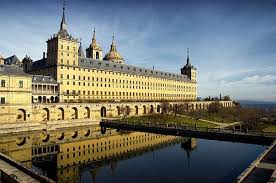Want to learn more about El Escorial in Spain? Read on for facts and info on this historical building of great prominence in the town of San Lorenzo in Spain…
El Escorial is the name of a historical architectural structure that once served as the residence belonging to the King of Spain. Over the course of history this religious site has served as a royal palace, monastery, school and today functions as a museum.
The property is located about 45 km from the capital city of Madrid. The town itself is known as San Lorenzo de El Escorial. The El Escorial is not the only important architectural complex in the town rather it is also the location for another important historical building known as El Real Monasterio. Both these sites served as houses of temporal power during the 16th and 17th century for the Spanish monarchy. They were prominent symbols of the Roman Catholic faith which can be clearly seen in the aesthetic sense that is employed in their design. At one point in time the El Escorial was functioning as a monastery and at the same time it served as the Spanish royal palace.
The property originally belonged to Hieronymite monks. However the ownership of the building was transferred to the Order of Saint Augustine and it now serves as the monastery for this particular order of Christianity.
By the 16th century the Protestant Reformation was gaining strength in Europe. Philip II was the ruler of Spain during that time and he made continuous efforts to stem the growing popularity of the Protestants. Although he was partly successful in his attempts, 30 years down the line the complex that he had built in honor of his faith was now being used to propagate the Protestant school of thought.
El Escorial Description
Juan Baustista de Toledo was the Spanish architect commissioned by the king to design the El Escorial. The architect had previously designed other important religious buildings such as the basilica skill of St. Peter in Naples. He acquired the status of the Royal Architect in 1559 and started working on the El Escorial which eventually served as one of the most important monuments of the Christian world during that period of time.
Today the site of El Escorial has been declared a world heritage site by UNESCO. It is also a popular tourist attraction and according to official records more than 500,000 people come to the town of San Lorenzo to witness the historical marvel of architecture.
The Royal building occupies an awkward location right at the foot of Mount Abantos in the region of Sierra de Guadarrama. The surrounding environment is a semi-forested land which is a popular site for iron mines that were rich once upon a time in history. Although the particular location is not very suitable for the construction of a royal palace, it was specifically chosen by King Philip II in commemoration of the Spanish victory of 1557 against the King of France. The King of Spain also authorized El Escorial to serve as a center for studies that would fuel the counter Protestant Reformation initiated by the King.





